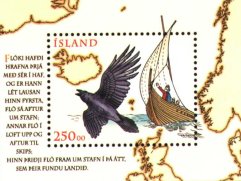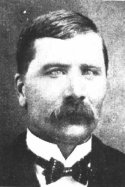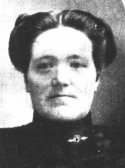According
to the early Icelandic historians, two at least of the first exploratory voyages to Iceland were launched from the Faroes in the middle of
|
Flóki has released his third raven
which flies straight to Iceland |
the ninth century. There is mention of an outlawed Norwegian Viking called
Naddod; he was on his way home to the Faroes, where he had settled, when he was storm-driven to the east coast of Iceland. He found no sign of human habitation, and left as soon as he could. As he sailed away the snow was falling heavily, so he called the country
Snćland (Snowland). Nonetheless he had much praise for the country when he reached the Faroes.
Another Norwegian Viking called
Flóki Vilgerđarson heard of the discovery and determined to settle in this new country. He held a great sacrifice, and dedicated to
Óđinn (the highest of the Gods) three ravens he intended to use as guides on the way. He paused at the Faroes on the way, where took the time to marrie off one of his daughters before he set sail for the north-west. When he was some way out he released one of the sacred ravens, which promptly headed straight back for the Faroes. Later he released the second of the ravens, which returned to the ship. When he released the third raven, it flew off towards some distantly sensed land far ahead, and now Flóki knew he was on the right way.
When he reached Iceland he sailed along the south coast and into the inviting bays of the west country. He and his companions found the waters teeming with fish. They spent all summer fishing to their hearts' content, but neglected to make any hay for the livestock they had brought with them. It was a hard winter and a late spring, and all their beasts died. While the northern fjords were still choked by sea-ice Flóki made haste to leave. He named the country
Iceland, and when he reached Norway he did not have a good word to say for it. One of his companions tried to give a more balanced view, saying that it had advantages as well as disadvantages; but another companion, a man called Ţórólfur (Thórólf), had been entranced by it, and said that butter dripped from every blade of grass. So Ţórólfur was nicknamed
Ţórólfur "smjör" (Thórólf Butter), while Flóki became known as
Hrafna-Flóki (Raven-Flóki).
The story of Raven-Flóki may smack of legend-making. Anyway, he came back later to Iceland and settled in the county of Skagafjörđur, in a valley which was later called by his name, Flókadalur (Flóki's valley). So, Iceland had received its misleadingly chilly name; but in the next few years, a host of Norse immigrants were to follow in Flóki's wake, hoping to find more butter than ice. And sure they did.
Ref. (mainly): "Viking expansion westwards, by Magnus Magnusson





